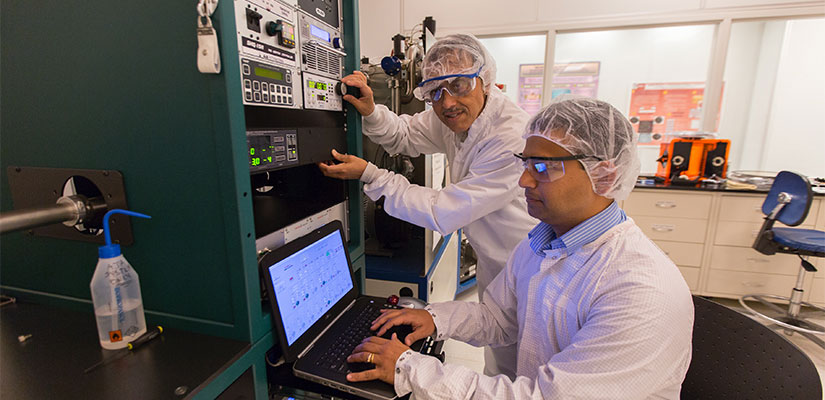Photo: (From left) Supriyo Bandyopadhyay, Ph.D., Commonwealth Professor in the Department of Electrical and Computer Engineering, and Jayasimha Atulasimha, Ph.D., Qimonda Professor in the Department of Mechanical and Nuclear Engineering
Two researchers in the VCU School of Engineering are harnessing the spin properties of electrons to design more efficient technologies. With funding from the National Science Foundation, Supriyo Bandyopadhyay, Ph.D., Commonwealth Professor in the Department of Electrical and Computer Engineering, and Jayasimha Atulasimha, Ph.D., Qimonda Professor in the Department of Mechanical and Nuclear Engineering, are creating novel systems that exploit electron spin to improve device functionality, a process called spintronics.
Electronics relies on the charge of electrons to store, process and communicate information. Spintronics, by contrast, uses the “up” or “down” direction of electron spin — not electron charge — to store or transmit bits of information in ones or zeros. Spintronic devices can process exponentially more data using significantly less energy than conventional electronics, and, unlike most conventional electronics, they can store data without requiring any external energy supply.
Atulasimha and Bandyopadhyay are leveraging spintronics for applications that include optical devices and cyber security. One of their inventions is a spintronic infrared photodetector. Photodetectors, which convert light into an electrical signal, are used in technologies including night vision devices, car collision avoidance systems, mine detectors, missile defense and systems to measure global warming. The team’s spintronic device addresses a persistent challenge in infrared photodetector design: their tendency to misread normal thermal vibrations as the presence of infrared light. That is why these photodetectors have to be cooled well below room temperature in order to work. The VCU team has developed a spintronic photodetector technology that uses magnetic contacts and a semiconductor nanowire and is immune to the effect of thermal vibrations. “The nanowire should ideally have nearly infinite electrical resistance in the dark and a much lower resistance under infrared illumination even at room temperature. That makes it work as an infrared photodetector at room temperature,” Bandyopadhyay said.
They are also using nanoscale magnets that store information and are connected by semiconductor nanowires to develop a novel magnetic/spintronic version of bit comparators, an essential component of electronic circuits and cyber security keys. Bit comparators analyze extremely complex strings of data, one bit at a time, and render a yes/no decision as to whether each bit matches a corresponding stored bit. Magnetic bit comparators offer a key advantage over their electronic counterparts. “If you build [a bit comparator] in a typical transistor device, when you switch off the power, the information is lost. In a nanomagnet, the comparator’s inputs and decision stay there forever — In fact, it could stay there for centuries. We call such a device non-volatile,” Atulasimha said.
The two VCU researchers are collaborating with Arunkumar Subramanian, Ph.D., associate professor in the Department of Mechanical and Industrial Engineering at the University of Illinois at Chicago. He is a co-investigator on the NSF grant and uses dielectrophoresis (DEP) to assemble semiconductor nanowires between magnetic contacts.
HOW IT WORKS: Building a Nanoscale Semiconductor for Spintronic Devices
The spintronic systems that Atulasimha and Bandyopadhyay are designing rely on novel nanoscale semiconductor systems that use magnets to manipulate the spin of electrons, and then block stray electrons that may produce an erroneous reading. “The presence of light will knock electrons from the atoms, and these electrons create a current that photodetectors sense,” Bandyopadhyay said. “The problem is that thermal vibrations can also knock electrons off atoms, so even in the dark you can get some loose electrons floating around. We want to be sure that no random current is generated in the dark, even at room temperature.”
The team is solving this problem by placing a nanostructure semiconductor system — a “nanowire” several thousand times finer than a human hair — between two magnetic contacts. The nanowire is made of a material (such as a semiconductor with a wide bandgap) where neither light nor thermal vibrations can knock electrons off the atoms to create electrons. A battery placed between the two contacts injects electrons into the nanowire. These electrons pass through the first magnet, which polarizes their spins in a single direction. Then they move through the nanowire, where random current generated by temperature instead of light is virtually eliminated. The second magnet, which is magnetized in the opposite direction, blocks the spin-polarized electrons from transmitting through, reducing the dark current ideally to zero.
“When light is turned on, it does not create extra electrons, but excites the existing electrons to higher energy states and makes some of their spins flip. The latter are transmitted by the second magnet contact, giving rise to a current under illumination. “The challenge is to make the magnetic contacts excellent spin polarizers and analyzers by proper choice of magnetic materials and careful engineering,” Bandyopadhyay said.
Their bit comparator design has the same structure as the photodetector: a nanowire with two magnetic contacts. The magnetization of one contact represents the programmed bit and that of the other contact represents the input bit. Bits are “written” into the contacts by aligning their magnetizations with electrically generated strain. When the two bits match, the contacts’ magnetizations are mutually parallel and the device has a low resistance. When they don’t match, the magnetizations are not parallel and the resistance is higher. The resistance provides a measure of the match/mismatch condition. “The challenges are similar — one needs the contacts to be good spin polarizers and analyzers,” Atulasimha said. “Additionally, one should be able to write the bits reliably into the contacts’ magnetization states with strain. This technology will produce a magnetic comparator that is non-volatile and energy efficient.”
